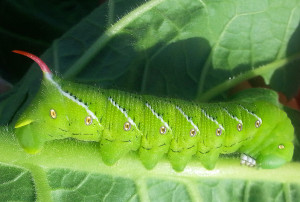Mid Summer Tobacco Insect Update
go.ncsu.edu/readext?224347
en Español / em Português
El inglés es el idioma de control de esta página. En la medida en que haya algún conflicto entre la traducción al inglés y la traducción, el inglés prevalece.
Al hacer clic en el enlace de traducción se activa un servicio de traducción gratuito para convertir la página al español. Al igual que con cualquier traducción por Internet, la conversión no es sensible al contexto y puede que no traduzca el texto en su significado original. NC State Extension no garantiza la exactitud del texto traducido. Por favor, tenga en cuenta que algunas aplicaciones y/o servicios pueden no funcionar como se espera cuando se traducen.
Português
Inglês é o idioma de controle desta página. Na medida que haja algum conflito entre o texto original em Inglês e a tradução, o Inglês prevalece.
Ao clicar no link de tradução, um serviço gratuito de tradução será ativado para converter a página para o Português. Como em qualquer tradução pela internet, a conversão não é sensivel ao contexto e pode não ocorrer a tradução para o significado orginal. O serviço de Extensão da Carolina do Norte (NC State Extension) não garante a exatidão do texto traduzido. Por favor, observe que algumas funções ou serviços podem não funcionar como esperado após a tradução.
English
English is the controlling language of this page. To the extent there is any conflict between the English text and the translation, English controls.
Clicking on the translation link activates a free translation service to convert the page to Spanish. As with any Internet translation, the conversion is not context-sensitive and may not translate the text to its original meaning. NC State Extension does not guarantee the accuracy of the translated text. Please note that some applications and/or services may not function as expected when translated.
Collapse ▲Caterpillars Large and Small
So far this year, tobacco budworm numbers of in our research plots at both Kinston and Rocky Mount have remained below threshold (less than 10% of plants infested). However, this week we’ve noticed lots of egg laying activity at Kinston so more are on their way. While this is good news for those of us doing research on budworm control, scouting activity should focus on determing if economically signifciant populations of this pest are present.
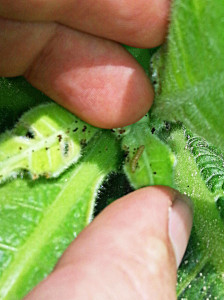
Notice the small, black specks of caterpillar ‘frass’ (droppings) as a sign of recent feeding by this young budworm at Kinston, NC. Photo: Demetri Tsiolkas
Two weeks ago, we found our first hornworms at our plots at Kinston, and last week, we found them at our Rocky Mount plots. We have found both species of hornworms, tobacco and tomato, in our plots at Kinston, but only tobacco hornworms, so far, at Rocky Mount. However, we found only a handful of hornworms in each 3 acre research plot, so we are still very much below the 10% threshold level, as is typical at this time of year.
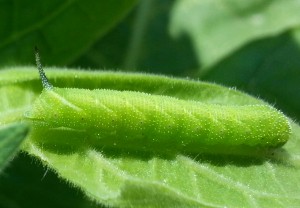
The tomato hornworm (above) has a blue horn on its tail end, and the tobacco hornworm (below) has a red horn. Photos: Demetri Tsiolkas
Natural Enemies
While keeping tabs on the pest insects present in our experiments, we did notice some beneficial insects at work as well.
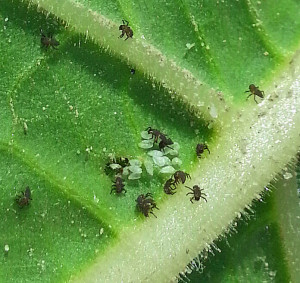
Ladybug larvae hatching at Kinston, NC: in addition to eating aphids, they feed on young caterpillars. Photo: Demetri Tsiolkas
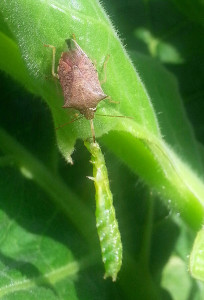
The spined solider bug can also feed on budworms at Kinston, NC. Spined soldier bugs are in the same family as pest stink bugs, but they can be distinguished by pronounced “points” on their shoulders. Photo: Demetri Tsiolkas
Natural enemies of caterpillar and aphid pests are common in southeastern tobacco fields, and they can often reduce or maintain pest populations below threshold on their own. Therefore, it’s important to continue to monitor insect pests before making management decisions.
Written by Aurora Toennisson, Research Association
Specialty Crops Laboratory, Department of Entomology



